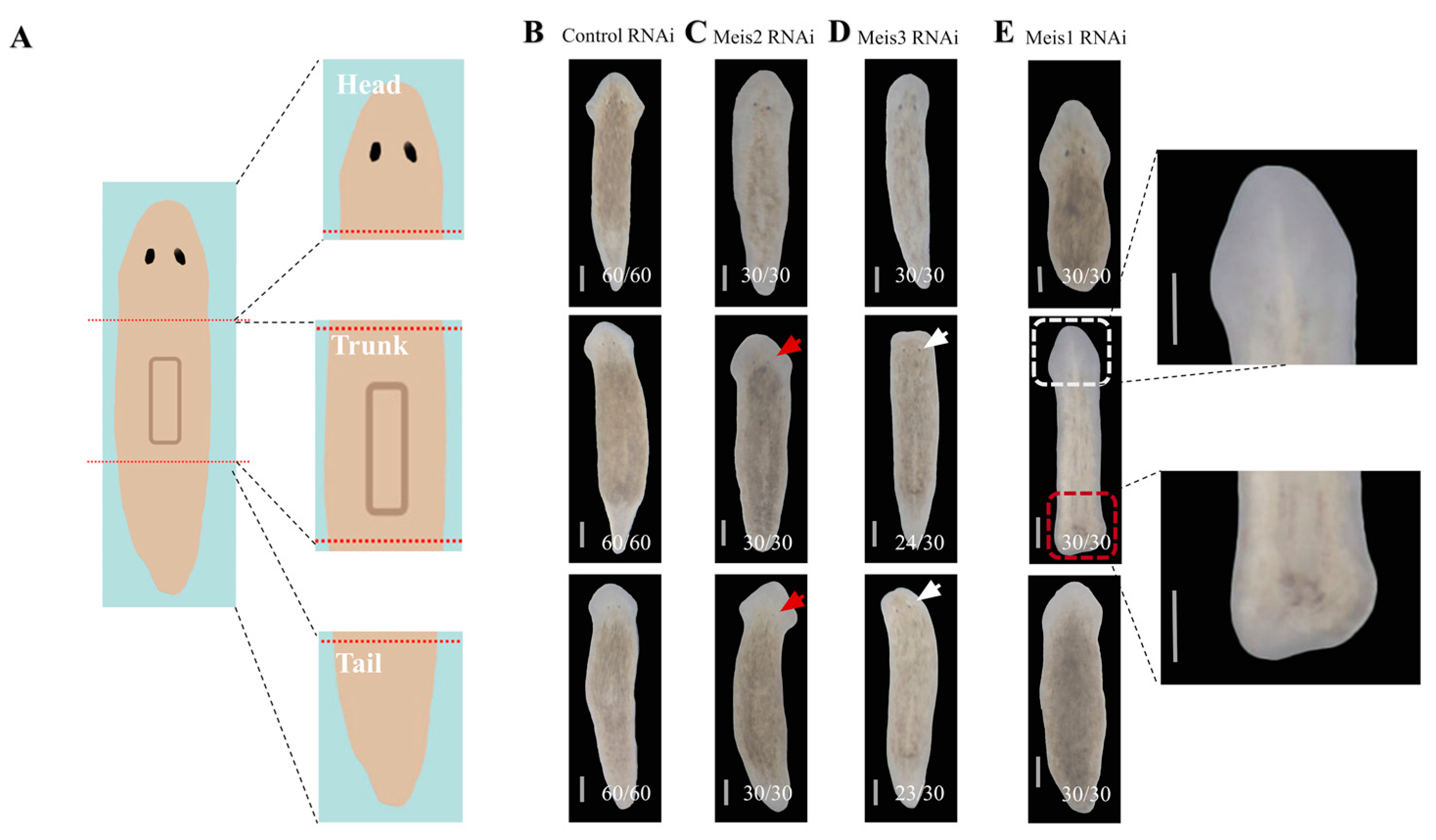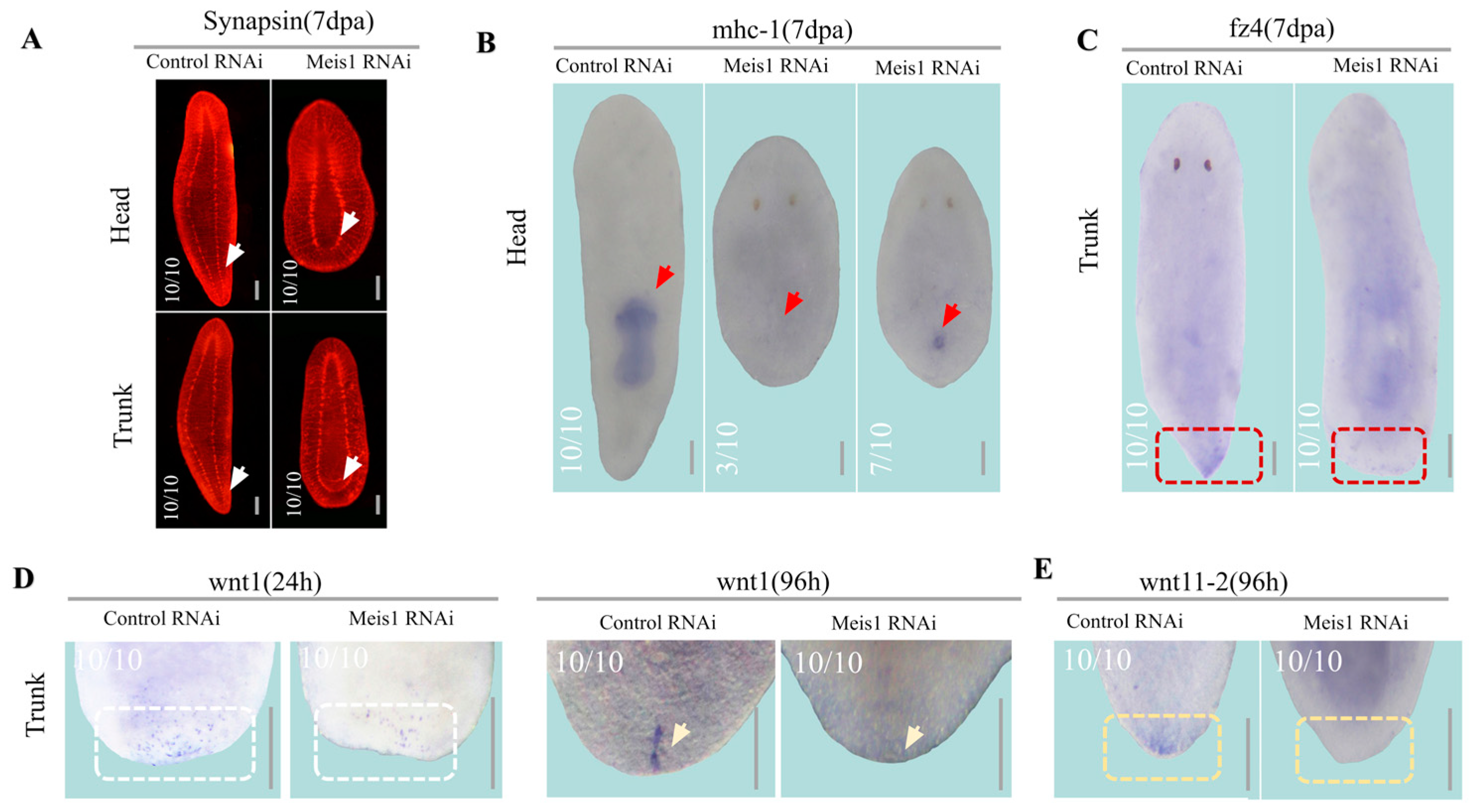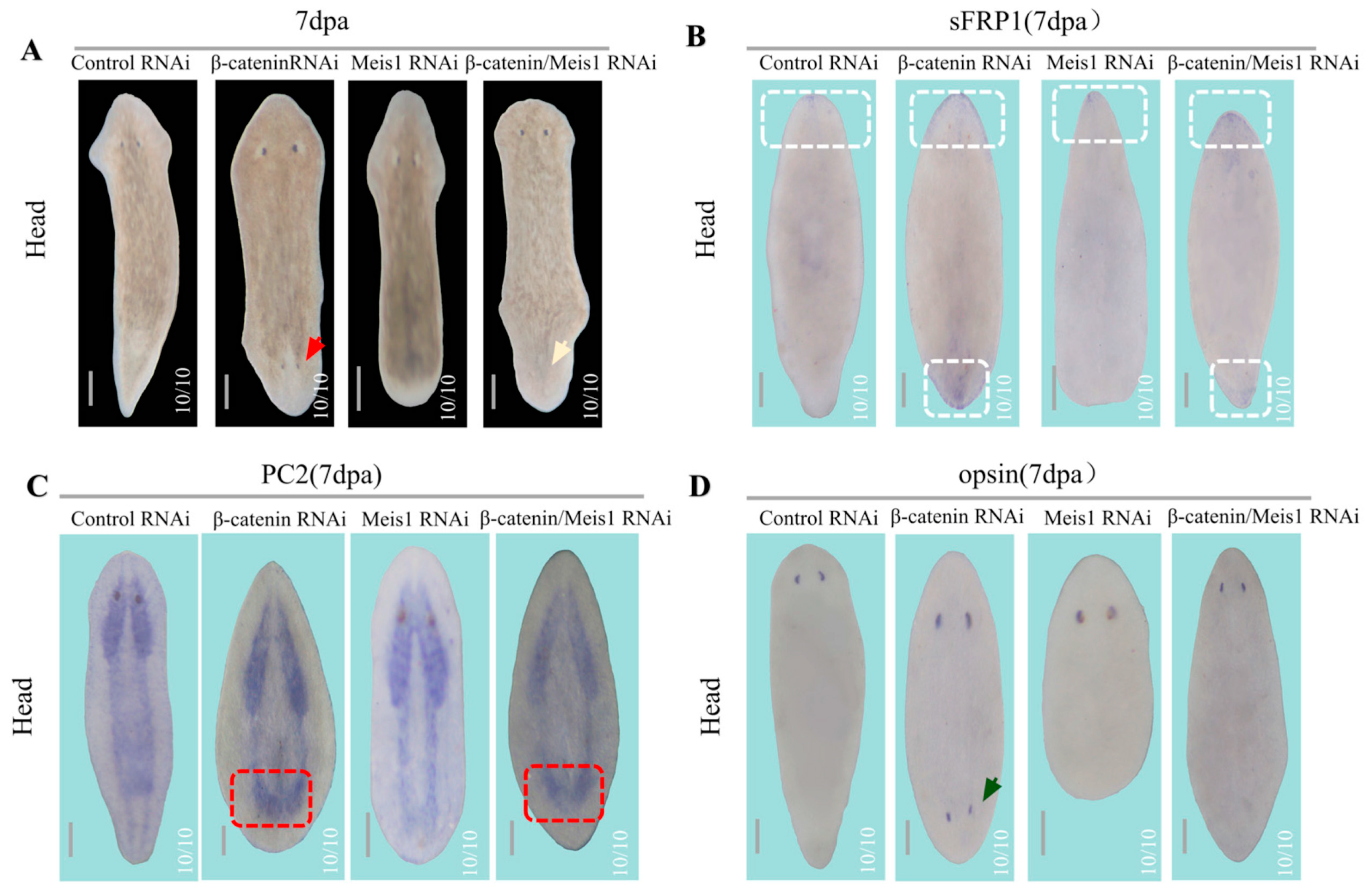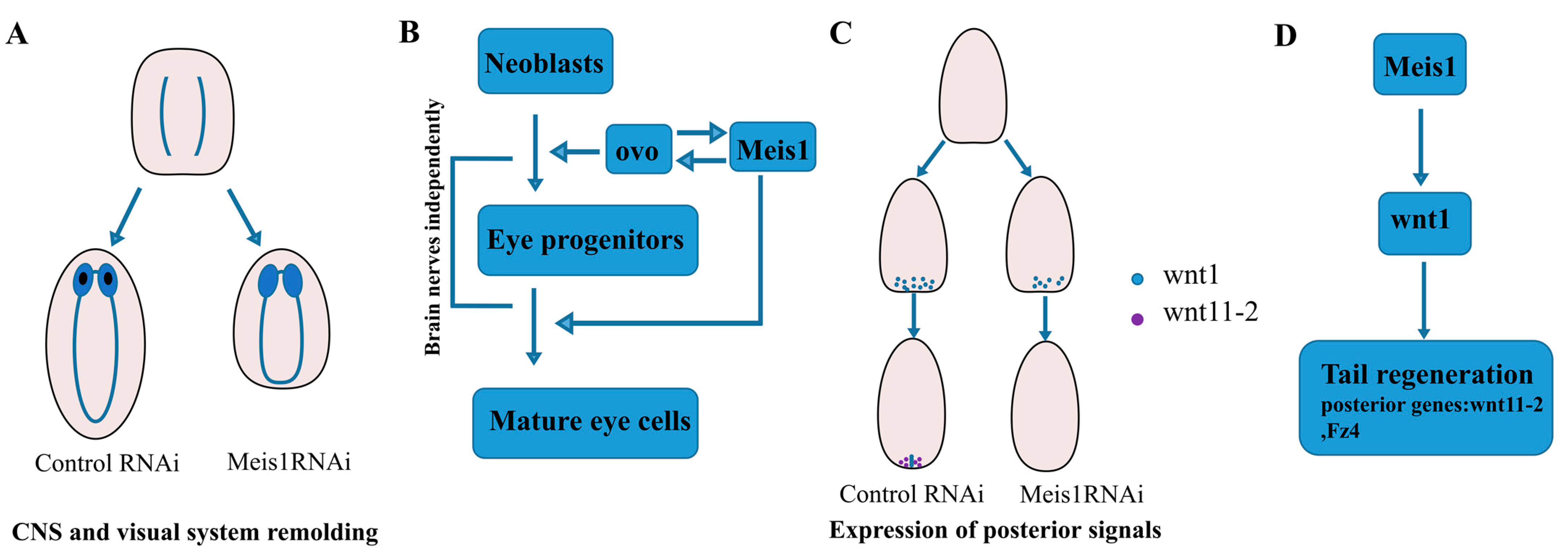Meis1 Controls the Differentiation of Eye Progenitor Cells and the Formation of Posterior Poles during Planarian Regeneration
Abstract
1. Introduction
2. Results
2.1. DjMeis1 RNAi Inhibits the Eye and Tail Regeneration
2.2. DjMeis1 Is Required for the Eye Regeneration by Regulating the Formation of Eye Progenitor Cells
2.3. DjMeis1 Control of the Tail Regeneration Is Independent of Cell Proliferation
2.4. DjMeis1 Is Required for the Re-Establishment of Posterior Poles by Regulating the Expression of Djwnt1
2.5. β-Catenin/DjMeis1 RNAi Induces the Posterior Poles of Planarians Reversal
3. Discussion
4. Materials and Methods
4.1. Species and Culture Conditions
4.2. Gene Cloning
4.3. RNAi
4.4. Whole-Mount In Situ Hybridization
4.5. Whole-Mount Immunostaining
4.6. Eye Resection
4.7. BrdU Labeling
4.8. Fluorescence In Situ Hybridization
4.9. Statistical Analyses
Supplementary Materials
Author Contributions
Funding
Institutional Review Board Statement
Informed Consent Statement
Data Availability Statement
Conflicts of Interest
References
- Isogai, E.; Okumura, K.; Saito, M.; Tokunaga, Y.; Wakabayashi, Y. Meis1 plays roles in cortical development through regulation of cellular proliferative capacity in the embryonic cerebrum. Biomed Res. 2022, 43, 91–97. [Google Scholar] [CrossRef] [PubMed]
- Delgado, I.; Giovinazzo, G.; Temino, S.; Gauthier, Y.; Balsalobre, A.; Drouin, J.; Torres, M. Control of mouse limb initiation and antero-posterior patterning by Meis transcription factors. Nat. Commun. 2021, 12, 3086. [Google Scholar] [CrossRef] [PubMed]
- Stankunas, K.; Shang, C.; Twu, K.Y.; Kao, S.C.; Jenkins, N.A.; Copeland, N.G.; Sanyal, M.; Selleri, L.; Cleary, M.L.; Chang, C.P. Pbx/Meis deficiencies demonstrate multigenetic origins of congenital heart disease. Circ. Res. 2008, 103, 702–709. [Google Scholar] [CrossRef] [PubMed]
- Paul, S.; Zhang, X.; He, J.Q. Homeobox gene Meis1 modulates cardiovascular regeneration. Semin. Cell Dev. Biol. 2020, 100, 52–61. [Google Scholar] [CrossRef]
- Hisa, T.; Spence, S.E.; Rachel, R.A.; Fujita, M.; Nakamura, T.; Ward, J.M.; Devor-Henneman, D.E.; Saiki, Y.; Kutsuna, H.; Tessarollo, L.; et al. Hematopoietic, angiogenic and eye defects in Meis1 mutant animals. Embo J. 2004, 23, 450–459. [Google Scholar] [CrossRef]
- Crijns, A.P.; de Graeff, P.; Geerts, D.; Ten Hoor, K.A.; Hollema, H.; van der Sluis, T.; Hofstra, R.M.; de Bock, G.H.; de Jong, S.; van der Zee, A.G.; et al. MEIS and PBX homeobox proteins in ovarian cancer. Eur. J. Cancer 2007, 43, 2495–2505. [Google Scholar] [CrossRef]
- Wang, G.G.; Pasillas, M.P.; Kamps, M.P. Meis1 programs transcription of FLT3 and cancer stem cell character, using a mechanism that requires interaction with Pbx and a novel function of the Meis1 C-terminus. Blood 2005, 106, 254–264. [Google Scholar] [CrossRef]
- Okumura, K.; Saito, M.; Isogai, E.; Aoto, Y.; Hachiya, T.; Sakakibara, Y.; Katsuragi, Y.; Hirose, S.; Kominami, R.; Goitsuka, R.; et al. Meis1 regulates epidermal stem cells and is required for skin tumorigenesis. PLoS ONE 2014, 9, e102111. [Google Scholar] [CrossRef]
- Li, W.; Huang, K.; Guo, H.; Cui, G. Meis1 regulates proliferation of non-small-cell lung cancer cells. J. Thorac. Dis. 2014, 6, 850–855. [Google Scholar]
- VanOpstall, C.; Perike, S.; Brechka, H.; Gillard, M.; Lamperis, S.; Zhu, B.; Brown, R.; Bhanvadia, R.; Vander Griend, D.J. MEIS-mediated suppression of human prostate cancer growth and metastasis through HOXB13-dependent regulation of proteoglycans. eLife 2020, 9, e53600. [Google Scholar] [CrossRef]
- Hay, E.D.; Coward, S.J. Fine structure studies on the planarian, Dugesia. I. Nature of the “neoblast” and other cell types in noninjured worms. J. Ultrastruct Res. 1975, 50, 1–21. [Google Scholar] [CrossRef]
- Pedersen, K.J. Cytological studies on the planarian neoblast. Z. Zellforsch Mikrosk Anat. 1959, 50, 799–817. [Google Scholar] [CrossRef]
- Goldsmith, E.D. Correlation in Planarian Regeneration. Proc. Natl. Acad. Sci. USA 1934, 20, 555–558. [Google Scholar] [CrossRef]
- Reddien, P.W.; Sánchez Alvarado, A. Fundamentals of planarian regeneration. Annu. Rev. Cell Dev. Biol. 2004, 20, 725–757. [Google Scholar] [CrossRef]
- Reddien, P.W.; Oviedo, N.J.; Jennings, J.R.; Jenkin, J.C.; Sánchez Alvarado, A. SMEDWI-2 is a PIWI-like protein that regulates planarian stem cells. Science 2005, 310, 1327–1330. [Google Scholar] [CrossRef]
- Rink, J.C. Stem cell systems and regeneration in planaria. Dev. Genes Evol. 2013, 223, 67–84. [Google Scholar] [CrossRef]
- Wagner, D.E.; Wang, I.E.; Reddien, P.W. Clonogenic neoblasts are pluripotent adult stem cells that underlie planarian regeneration. Science 2011, 332, 811–816. [Google Scholar] [CrossRef]
- Peiris, T.H.; Weckerle, F.; Ozamoto, E.; Ramirez, D.; Davidian, D.; Garcia-Ojeda, M.E.; Oviedo, N.J. TOR signaling regulates planarian stem cells and controls localized and organismal growth. J. Cell Sci. 2012, 125 Pt 7, 1657–1665. [Google Scholar]
- Reddien, P.W. The Cellular and Molecular Basis for Planarian Regeneration. Cell 2018, 175, 327–345. [Google Scholar] [CrossRef]
- Agata, K.; Watanabe, K. Molecular and cellular aspects of planarian regeneration. Semin. Cell Dev. Biol. 1999, 10, 377–383. [Google Scholar] [CrossRef]
- De Robertis, E.M. Wnt signaling in axial patterning and regeneration: Lessons from planaria. Sci. Signal 2010, 3, pe21. [Google Scholar] [CrossRef] [PubMed]
- Lander, R.; Petersen, C.P. Wnt, Ptk7, and FGFRL expression gradients control trunk positional identity in planarian regeneration. eLife 2016, 5, e12850. [Google Scholar] [CrossRef] [PubMed]
- Pascual-Carreras, E.; Sureda-Gomez, M.; Barrull-Mascaro, R.; Jorda, N.; Gelabert, M.; Coronel-Cordoba, P.; Salo, E.; Adell, T. WNT-FRIZZLED-LRP5/6 Signaling Mediates Posterior Fate and Proliferation during Planarian Regeneration. Genes 2021, 12, 101. [Google Scholar] [CrossRef] [PubMed]
- Petersen, C.P.; Reddien, P.W. A wound-induced Wnt expression program controls planarian regeneration polarity. Proc. Natl. Acad. Sci. USA 2009, 106, 17061–17066. [Google Scholar] [CrossRef] [PubMed]
- Petersen, C.P.; Reddien, P.W. Smed-betacatenin-1 is required for anteroposterior blastema polarity in planarian regeneration. Science 2008, 319, 327–330. [Google Scholar] [CrossRef]
- Chai, G.; Ma, C.; Bao, K.; Zheng, L.; Wang, X.; Sun, Z.; Salò, E.; Adell, T.; Wu, W. Complete functional segregation of planarian beta-catenin-1 and -2 in mediating Wnt signaling and cell adhesion. J. Biol. Chem. 2010, 285, 24120–24130. [Google Scholar] [CrossRef]
- Hill, E.M.; Petersen, C.P. Wnt/Notum spatial feedback inhibition controls neoblast differentiation to regulate reversible growth of the planarian brain. Development 2015, 142, 4217–4229. [Google Scholar] [CrossRef]
- Petersen, C.P.; Reddien, P.W. Polarized notum activation at wounds inhibits Wnt function to promote planarian head regeneration. Science 2011, 332, 852–855. [Google Scholar] [CrossRef]
- Blassberg, R.A.; Felix, D.A.; Tejada-Romero, B.; Aboobaker, A.A. PBX/extradenticle is required to re-establish axial structures and polarity during planarian regeneration. Development 2013, 140, 730–739. [Google Scholar] [CrossRef]
- Hayashi, T.; Motoishi, M.; Yazawa, S.; Itomi, K.; Tanegashima, C.; Nishimura, O.; Agata, K.; Tarui, H. A LIM-homeobox gene is required for differentiation of Wnt-expressing cells at the posterior end of the planarian body. Development 2011, 138, 3679–3688. [Google Scholar] [CrossRef]
- Tian, Q.; Guo, Q.; Guo, Y.; Luo, L.; Kristiansen, K.; Han, Z.; Fang, H.; Zhang, S. Whole-genome sequence of the planarian Dugesia japonica combining Illumina and PacBio data. Genomics 2022, 114, 110293. [Google Scholar] [CrossRef]
- Lapan, S.W.; Reddien, P.W. Transcriptome analysis of the planarian eye identifies ovo as a specific regulator of eye regeneration. Cell Rep. 2012, 2, 294–307. [Google Scholar] [CrossRef]
- Rodriguez-Esteban, G.; Gonzalez-Sastre, A.; Rojo-Laguna, J.I.; Salo, E.; Abril, J.F. Digital gene expression approach over multiple RNA-Seq data sets to detect neoblast transcriptional changes in Schmidtea mediterranea. BMC Genom. 2015, 16, 361. [Google Scholar] [CrossRef]
- Witchley, J.N.; Mayer, M.; Wagner, D.E.; Owen, J.H.; Reddien, P.W. Muscle cells provide instructions for planarian regeneration. Cell Rep. 2013, 4, 633–641. [Google Scholar] [CrossRef]
- Nogi, T.; Watanabe, K. Position-specific and non-colinear expression of the planarian posterior (Abdominal-B-like) gene. Dev. Growth Differ. 2001, 43, 177–184. [Google Scholar] [CrossRef]
- Li, D.J.; McMann, C.L.; Reddien, P.W. Nuclear receptor NR4A is required for patterning at the ends of the planarian anterior-posterior axis. eLife 2019, 8, e42015. [Google Scholar] [CrossRef]
- Scimone, M.L.; Cote, L.E.; Rogers, T.; Reddien, P.W. Two FGFRL-Wnt circuits organize the planarian anteroposterior axis. eLife 2016, 5, e12845. [Google Scholar] [CrossRef]
- Inoue, T.; Kumamoto, H.; Okamoto, K.; Umesono, Y.; Sakai, M.; Sanchez Alvarado, A.; Agata, K. Morphological and functional recovery of the planarian photosensing system during head regeneration. Zool. Sci. 2004, 21, 275–283. [Google Scholar] [CrossRef]
- Agata, K.; Soejima, Y.; Kato, K.; Kobayashi, C.; Umesono, Y.; Watanabe, K. Structure of the planarian central nervous system (CNS) revealed by neuronal cell markers. Zool. Sci. 1998, 15, 433–440. [Google Scholar] [CrossRef]
- Karge, A.; Bonar, N.A.; Wood, S.; Petersen, C.P. tec-1 kinase negatively regulates regenerative neurogenesis in planarians. eLife 2020, 9, e47293. [Google Scholar] [CrossRef]
- Okamoto, K.; Takeuchi, K.; Agata, K. Neural projections in planarian brain revealed by fluorescent dye tracing. Zool. Sci. 2005, 22, 535–546. [Google Scholar] [CrossRef] [PubMed]
- Cross, S.D.; Johnson, A.A.; Gilles, B.J.; Bachman, L.A.; Inoue, T.; Agata, K.; Marmorstein, L.Y.; Marmorstein, A.D. Control of Maintenance and Regeneration of Planarian Eyes by ovo. Investig. Ophthalmol. Vis. Sci. 2015, 56, 7604–7610. [Google Scholar] [CrossRef] [PubMed]
- Mannini, L.; Rossi, L.; Deri, P.; Gremigni, V.; Salvetti, A.; Salo, E.; Batistoni, R. Djeyes absent (Djeya) controls prototypic planarian eye regeneration by cooperating with the transcription factor Djsix-1. Dev. Biol. 2004, 269, 346–359. [Google Scholar] [CrossRef]
- Degl’Innocenti, A.; Rossi, L.; Salvetti, A.; Marino, A.; Meloni, G.; Mazzolai, B.; Ciofani, G. Chlorophyll derivatives enhance invertebrate red-light and ultraviolet phototaxis. Sci. Rep. 2017, 7, 3374. [Google Scholar] [CrossRef] [PubMed]
- Dong, Z.; Yuwen, Y.; Sima, Y.; Dong, Y.; Zhan, H.; Chen, G.; Liu, D. Photokinesis and Djopsin gene expression analysis during the regeneration of planarian eyes. Integr. Zool. 2017, 12, 157–164. [Google Scholar] [CrossRef]
- Tu, K.C.; Cheng, L.-C.; Vu, H.T.; Lange, J.J.; McKinney, S.A.; Seidel, C.W.; Alvarado, A.S. Egr-5 is a post-mitotic regulator of planarian epidermal differentiation. eLife 2015, 4, e10501. [Google Scholar] [CrossRef]
- Han, X.S.; Wang, C.; Guo, F.H.; Huang, S.; Qin, Y.W.; Zhao, X.X.; Jing, Q. Neoblast-enriched zinc finger protein FIR1 triggers local proliferation during planarian regeneration. Protein. Cell 2019, 10, 43–59. [Google Scholar] [CrossRef]
- Wang, C.; Peng, R.; Yuan, X.; Liu, S.; Xu, S.; Li, Y.; Zhang, Z.; Zeng, M.; Hu, L.; Zou, F. Cellular and molecular responses-mediated by DjMEK1/2 are necessary for planarian regeneration. Int. J. Biol. Macromol. 2020, 164, 3751–3761. [Google Scholar] [CrossRef]
- Wang, Q.; Liu, Y.; Jin, B.; Dong, Z.; Chen, G.; Liu, D. Djmek is involved in planarian regeneration by regulation of cell proliferation and apoptosis. Biochem. Biophys. Res. Commun. 2020, 532, 355–361. [Google Scholar] [CrossRef]
- Umesono, Y.; Agata, K. Evolution and regeneration of the planarian central nervous system. Dev. Growth Differ. 2009, 51, 185–195. [Google Scholar] [CrossRef]
- Collins, J.J., 3rd; Hou, X.; Romanova, E.V.; Lambrus, B.G.; Miller, C.M.; Saberi, A.; Sweedler, J.V.; Newmark, P.A. Genome-wide analyses reveal a role for peptide hormones in planarian germline development. PLoS Biol. 2010, 8, e1000509. [Google Scholar] [CrossRef]
- Bohr, T.E.; Shiroor, D.A.; Adler, C.E. Planarian stem cells sense the identity of the missing pharynx to launch its targeted regeneration. eLife 2021, 10, e68830. [Google Scholar] [CrossRef]
- Sureda-Gomez, M.; Martin-Duran, J.M.; Adell, T. Localization of planarian beta-CATENIN-1 reveals multiple roles during anterior-posterior regeneration and organogenesis. Development 2016, 143, 4149–4160. [Google Scholar]
- Jiang, M.; Xu, S.; Bai, M.; Zhang, A. The emerging role of MEIS1 in cell proliferation and differentiation. Am. J. Physiol. Cell Physiol. 2021, 320, C264–C269. [Google Scholar] [CrossRef]
- Wang, H.; Liu, C.; Liu, X.; Wang, M.; Wu, D.; Gao, J.; Su, P.; Nakahata, T.; Zhou, W.; Xu, Y.; et al. MEIS1 Regulates Hemogenic Endothelial Generation, Megakaryopoiesis, and Thrombopoiesis in Human Pluripotent Stem Cells by Targeting TAL1 and FLI1. Stem. Cell Rep. 2018, 10, 447–460. [Google Scholar] [CrossRef]
- Yao, M.Z.; Ge, X.Y.; Liu, T.; Huang, N.; Liu, H.; Chen, Y.; Zhang, Z.; Hu, C.P. MEIS1 regulated proliferation and migration of pulmonary artery smooth muscle cells in hypoxia-induced pulmonary hypertension. Life Sci. 2020, 255, 117822. [Google Scholar] [CrossRef]
- Namekata, M.; Yamamoto, M.; Goitsuka, R. Nuclear localization of Meis1 in dermal papilla promotes hair matrix cell proliferation in the anagen phase of hair cycle. Biochem. Biophys Res. Commun. 2019, 519, 727–733. [Google Scholar] [CrossRef]
- Yujia, S.; Tingting, G.; Jiaxin, L.; Saisai, Z.; Zhitai, H.; Qingnan, T.; Shoutao, Z. Cdc42 regulate the apoptotic cell death required for planarian epidermal regeneration and homeostasis. Int. J. Biochem. Cell Biol. 2019, 112, 107–113. [Google Scholar] [CrossRef]
- Tian, Q.N.; Bao, Z.X.; Lu, P.; Qin, Y.F.; Chen, S.J.; Liang, F.; Mai, J.; Zhao, J.M.; Zhu, Z.Y.; Zhang, Y.Z.; et al. Differential expression of microRNA patterns in planarian normal and regenerative tissues. Mol. Biol. Rep. 2012, 39, 2653–2658. [Google Scholar] [CrossRef]
- Rouhana, L.; Weiss, J.A.; Forsthoefel, D.J.; Lee, H.; King, R.S.; Inoue, T.; Shibata, N.; Agata, K.; Newmark, P.A. RNA interference by feeding in vitro-synthesized double-stranded RNA to planarians: Methodology and dynamics. Dev. Dyn. 2013, 242, 718–730. [Google Scholar] [CrossRef]
- Pearson, B.J.; Eisenhoffer, G.T.; Gurley, K.A.; Rink, J.C.; Miller, D.E.; Sánchez Alvarado, A. Formaldehyde-based whole-mount in situ hybridization method for planarians. Dev. Dyn. 2009, 238, 443–450. [Google Scholar] [CrossRef] [PubMed]
- Atabay, K.D.; LoCascio, S.A.; de Hoog, T.; Reddien, P.W. Self-organization and progenitor targeting generate stable patterns in planarian regeneration. Science 2018, 360, 404–409. [Google Scholar] [CrossRef] [PubMed]
- Cheng, L.C.; Alvarado, A.S. Whole-Mount BrdU Staining with Fluorescence In Situ Hybridization in Planarians. Methods Mol. Biol. 2018, 1774, 423–434. [Google Scholar] [PubMed]






Disclaimer/Publisher’s Note: The statements, opinions and data contained in all publications are solely those of the individual author(s) and contributor(s) and not of MDPI and/or the editor(s). MDPI and/or the editor(s) disclaim responsibility for any injury to people or property resulting from any ideas, methods, instructions or products referred to in the content. |
© 2023 by the authors. Licensee MDPI, Basel, Switzerland. This article is an open access article distributed under the terms and conditions of the Creative Commons Attribution (CC BY) license (https://creativecommons.org/licenses/by/4.0/).
Share and Cite
Wang, S.; Sun, Y.; Liu, X.; Guo, Y.; Huang, Y.; Zhang, S.; Tian, Q. Meis1 Controls the Differentiation of Eye Progenitor Cells and the Formation of Posterior Poles during Planarian Regeneration. Int. J. Mol. Sci. 2023, 24, 3505. https://doi.org/10.3390/ijms24043505
Wang S, Sun Y, Liu X, Guo Y, Huang Y, Zhang S, Tian Q. Meis1 Controls the Differentiation of Eye Progenitor Cells and the Formation of Posterior Poles during Planarian Regeneration. International Journal of Molecular Sciences. 2023; 24(4):3505. https://doi.org/10.3390/ijms24043505
Chicago/Turabian StyleWang, Shaocong, Yujia Sun, Xiaomai Liu, Yajun Guo, Yongding Huang, Shoutao Zhang, and Qingnan Tian. 2023. "Meis1 Controls the Differentiation of Eye Progenitor Cells and the Formation of Posterior Poles during Planarian Regeneration" International Journal of Molecular Sciences 24, no. 4: 3505. https://doi.org/10.3390/ijms24043505
APA StyleWang, S., Sun, Y., Liu, X., Guo, Y., Huang, Y., Zhang, S., & Tian, Q. (2023). Meis1 Controls the Differentiation of Eye Progenitor Cells and the Formation of Posterior Poles during Planarian Regeneration. International Journal of Molecular Sciences, 24(4), 3505. https://doi.org/10.3390/ijms24043505





